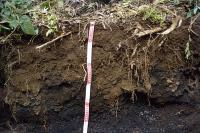Reference soil Nicaragua 05: Andosol
Andosols occur throughout the world where volcanic activity is common, especially in the circum-Pacific region and along the mid-Atlantic Ridge.
Characteristics
Soils with a vitric or andic horizon (slightly to moderately weathered horizons in pyroclastic deposits dominated by short-range-order minerals, notably allophane and imogolite) starting within 25 cm from the soil surface. In addition, they may have a histic, fulvic, melanic, mollic, umbric, ochric, duric, or cambic horizon. Other diagnostic horizons (unless buried deeper than 50 cm by volcanic deposits) are absent.
Reference soil NI005: Andosols
Shallow, young, (somewhat) excessively drained, black loamy sand soil developed from volcanic ejecta, derived from unconsolidated pyroclastic rock (ash, lapilli, volcanic bombs). The soil contains fresh pyroclastic fragments, is weakly structured, highly porous and highly erodable. At the surface an accumulation of about 2 cm of organic material is found. The densily closed natural vegetation prevents soil erosion. The profile forms part of the NIC05 to NIC09 toposequence.
